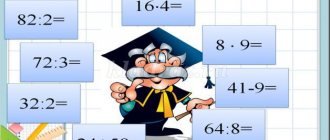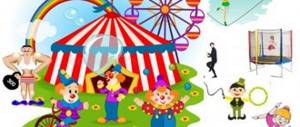Integers
NATURAL NUMBERS are numbers that are used in counting. 1, 2, 3, 4, 5, 6, 7, 8, 9, 10, 11, 12, 13, 14, 15, 16, 17, 18, 19, 20, …, 1 is the smallest number, and the most there is not a large number. The number 0 (zero) indicates the absence of an item. Zero NOT a natural number.
Places and classes of natural numbers
The DECIMAL NUMERAL SYSTEM is used to record numbers . In the decimal number system, units are used, tens of units, tens of tens - hundreds, etc. Each new unit of counting is exactly 10 times larger than the previous one:
The decimal number system is positional. In this number system, the meaning of each digit in a number depends on its position (place).
The position (place) of a digit in a number record is called DIGIT . The lowest digit is UNITS . Then follow TENS, HUNDREDS, THOUSANDS , etc.
Every three digits of natural numbers form a CLASS .
Poster “Do your homework yourself!” Grades 3-4 https://delayurokisam.rf
View the poster!
The main question that parents often ask is: why does the child need this knowledge? The answer to this question is very simple - after studying this material, children move on to topics such as addition and subtraction in a column, where it is necessary to know the digits of a number in order to correctly calculate examples.
And if the child does not master this topic, then he will not be able to solve columns correctly.
Adding and subtracting through digits
Column addition
A) Add up the units: 4 + 3 = 7. Write under the units. B) Add up the tens: 4 + 3 = 7. Write under the tens. C) Add up the hundreds: 4 + 3 = 7. Write under the hundreds. Answer: 777
Column subtraction
A) Subtract the units: 9 – 3 = 6. Write it under the units. B) Subtract tens: 0 is less than 2, occupy in hundreds (thousands).
10 – 2 = 8. Write it under tens. C) Subtract hundreds: 9 – 4 = 5. Write under hundreds. Answer: 586
Designation of natural numbers (Digits and classes in the notation of numbers)
Lesson objectives:
1) Educational: to form an idea of the role of digits and classes in writing a natural number and the skill of representing a natural number as a sum of digit terms, to introduce the numbering of digits and their names, as well as the names of classes in writing a natural number, to create conditions for improving reading skills and writing natural numbers.
2) Developmental: promote the development of attention, memory, thinking.
3) Educational: to cultivate interest in the subject of mathematics, curiosity, and observation.
During the classes:
1. Organizational stage.
Hello. Before we start the lesson, I would like to know how you feel about working in the lesson.
2. Updating basic knowledge:
A number is written on the board (for example, 789,540).
- Read the number. Please name the number that shows the number of units of the number, and the number that shows the number of tens. And what number shows the number of hundreds? Well done!
I would like to remind you that in the positional number system the position (place) of a digit means a number.
Open your notebooks and write down the date and topic of our lesson.
3. Knowledge acquisition stage:
Today in the lesson we will talk about ranks and classes in writing numbers. We will learn such concepts as digit of a number, digit units, digit terms, consider the classification of classes in the notation of numbers, and also learn how to correctly read natural numbers.
We already know that natural numbers are numbers that are used in counting. Any natural number can be written using ten digits.
The way we write numbers is called the decimal number system. The meaning of a digit depends on its place (position) in the number record.
In addition to natural numbers, we also know the number 0 (zero). When counting, the number 0 (zero) is not used, but means “not one.” Therefore, the number 0 is not a natural number!
If the representation of a natural number consists of one sign - one
numbers, then it is called single-digit.
For example, the numbers 1, 3, 7 are single digits.
If a number consists of two characters - two digits (different or identical), then it is called two-digit.
the numbers 23, 58, 66 are two-digit numbers, the same can be said about three-digit numbers, four-digit numbers, etc.
numbers 321, 555, 878 are three-digit numbers,
numbers 2100, 5350, 9999 are four-digit numbers
Multi-digit natural numbers are natural numbers whose notation consists of two or three or four, etc. digits. In mathematical terms, multi-digit natural numbers are two-digit, three-digit, four-digit, etc. numbers.
The position (place) in which a digit appears in the notation of a natural number is called a digit. The digits are named starting from the end of the number, i.e. from right to left. Let's consider, for clarity, the number 563.
The first digit to the right in a number is called the first digit (in this number it is the number 3), the second digit, which is next to the left of the first digit, is called the second digit (in the written number it is 6), the third digit is called the third digit (here this is the number 5). The first digit is also called the units digit, the second digit is the tens digit, the third digit is the hundreds digit, etc.
The same digit in a number can have different meanings depending on what digit it is in. If a number is missing any digit, then the number will be written in its place with the number 0 (zero).
Take, for example, the number 505. Here the number 5 is repeated. One digit 5 is in the first digit, which means that there are 5 units in the number, the second digit 5 is in the third digit and means that there are 5 hundreds in the number. The number 0 in 505 means that there is no tens place in the number.
Consider the number 8503. It consists of 8 thousand, 5 hundreds, 0 tens and 3 units. That is, it can be written as follows:
8503 = 8000 + 500 + 0 + 3
The numbers 8000, 500, 0 and 3 are called the digit terms of the number 8503.
The numbers 1, 10, 100, etc. are called digit units:
1 - unit of the first digit - units digit,
10 - unit of the second digit - tens digit,
100 is a unit of the third digit - the hundreds place, etc. With their help, a natural number is written in the form of digit terms.
Every 10 units of any rank form a new unit of a higher rank. For example, 10 ones make 1 ten, and 10 tens make 1 hundred. Let's look at this in the figure: we see 1 ball - let's denote it as 1 unit, if you connect 10 balls, then they will already form 1 ten, and 10 tens of balls will already make 1 hundred.
Let's return to the number 8503. We have already written it as the sum of the bit terms, we have written:
8503=8000 + 500 + 0 + 3
Now let's write the numbers 8000, 500, 0 and 3 using digit units. We get:
8503 = 8*1000 + 5*100 + 0*10 + 3*1 (speak, *- multiplication)
The first digit from the left in a natural number is called the highest digit. Since a natural number cannot begin with zero, the highest digit is always different from zero.
In writing a number, the digits, starting from the right, are grouped into classes of three digits each. Class of units, class of thousands, class of millions. There are names for the following classes - billions, trillions, quadrillions, etc.
The units class, or first class, is the class formed by the first three digits (to the right of the end of the number): the units place, the tens place, and the hundreds place.
For example, the numbers 6, 34, 148. All digits in the recording of these numbers are in the unit class.
The class of thousands or the second class is a class that is formed by the following three categories: units of thousands, tens of thousands and hundreds of thousands.
For example, the numbers 5234, 12803, 356149. The three digits on the right in these numbers are in the units class, and the rest are in the thousands class.
The class of millions or third class is a class that is formed by the following three categories: units of millions, tens of millions and hundreds of millions.
For example, the number 289 350 140. The first three digits are in the units class, the second three digits are in the thousands class, the third three digits are in the millions class.
To read a multi-digit number, we must break it down into classes and then say, from left to right, the number of units of each class, adding the name of the classes. If any of the classes contains 3 zeros, then the ones and the name of this class are not pronounced.
For example, let's read the number 134,590,720. To do this, put the digits of the number in a table with their corresponding rank and class. The number 0 refers to the ones place, 2 - to the tens place, 7 - to the hundreds place, the number 0 refers to the thousands place, 9 - to the tens of thousands, 5 - to the hundreds of thousands. Next is the number 4, it refers to the category of units of millions, 3 - to tens of millions and the number 1 refers to the category of hundreds of millions. Now let's read the number: one hundred thirty-four million five hundred ninety thousand seven hundred twenty.
Let's try to read the number 418,000,547 in the same way. Let's put the numbers in the table. 7 is the ones place, 4 is the tens place, 5 is the hundreds place. This is followed by 3 zeros, which respectively belong to the units, tens, and hundreds places of the thousands class. Then comes the number 8, it belongs to the category of units of millions, 1 - to the category of tens of millions and the number 4 belongs to the category of hundreds of millions. We read the number: “four hundred eighteen million five hundred and forty-seven.” The thousands class was not named because it contains three zeros.
4. Stage of generalization and consolidation of new material.
So, let's draw the main conclusions:
Today in the lesson we learned that the digit of a number is the position (place) in which the digit appears in the notation of a natural number. We learned to write numbers using place value terms. We looked at what classes of numbers exist, and also learned how to correctly read natural numbers.
To consolidate the material, answer the questions:
What numbers are called single-digit, two-digit, three-digit? Name the digits of the thousands class. Name the first five classes in the notation of natural numbers. How are multi-digit numbers read?
5. Reflection.
I would like to know if you liked the lesson? What was not clear in the lesson? What else would you like to know?
Number digits
All natural numbers are written using 10 digits from zero to nine. This number system is called decimal.
In addition, this system is positional; digital symbols can change position. The value of each subsequent position is 10 times greater than the previous one - units, tens, hundreds, thousands, etc.
Example 1
There are numbers 321 and 123. Let's see what they mean by adding first the units, then the tens, then the hundreds:
321 = 1 * 1 + 2 * 10 + 3 * 100;
123 = 3 * 1 + 2 * 10 + 1 * 100.
The example shows that the digital symbols change their location. At the same time, the numerical value changes - in the first case it is greater.
The place that a digit occupies in a number is called its digit.
The name of each element corresponds to the names of the counting values in the decimal system. Position selection occurs from right to left, from smallest to largest.
Important!
Zero denotes the absence of ones in the digit position. Therefore he cannot stand in the highest position. For example, writing twenty-three as “023” is incorrect. The correct spelling is 23.
The assignment of digits to one place or another in a numerical notation is called the bit composition of a number.
Example 2
Break down the number 275 into its digit components.
Solution:
- 5 is located at the 1st digit position (units);
- 7 – in the II place of tens;
- 2 - in the third hundreds place.
Classes and ranks
In writing a number, the digits, starting from the right, are grouped into classes of three digits each.
The units class , or first class, is the class formed by the first three digits (to the right of the end of the number): the units place, the tens place, and the hundreds place.
Example 1
| Numbers | Unit class (first class) | ||
| Hundreds | Dozens | Units | |
| 6 | — | — | 6 |
| 34 | — | 3 | 4 |
| 148 | 1 | 4 | 8 |
The class of thousands or the second class is a class that is formed by the following three categories: units of thousands, tens of thousands and hundreds of thousands.
Example 2
| Numbers | Thousands class (second class) | Unit class (first class) | ||||
| Hundreds of thousands | Tens of thousands | Units of thousands | Hundreds | Dozens | Units | |
| 5 234 | — | — | 5 | 2 | 3 | 4 |
| 12 893 | — | 1 | 2 | 8 | 9 | 3 |
| 356 149 | 3 | 5 | 6 | 1 | 4 | 9 |
We remind you that 10 units of the hundreds place (from the units class) form one thousand (the unit of the next place: the unit of thousands in the class of thousands). 10 hundreds = 1 thousand
The class of millions or third class is a class that is formed by the following three categories: units of millions, tens of millions and hundreds of millions.
The unit of the million place is one million or one thousand thousand (1,000 thousand). One million can be written as the number "1,000,000".
Ten such units form a new bit unit - ten million "10,000,000"
Ten tens of millions form a new digit unit - one hundred million, or written in numbers “100,000,000”.
Example 3
| Numbers | Million class (third class) | Thousands class (second class) | Unit class (first class) | ||||||
| Hundreds | Dozens | Units | Hundreds | Dozens | Units | Hundreds | Dozens | Units | |
| 8 345 216 | — | — | 8 | 3 | 4 | 5 | 2 | 1 | 6 |
| 93 785 342 | — | 9 | 3 | 7 | 8 | 5 | 3 | 4 | 2 |
| 134 598 721 | 1 | 3 | 4 | 5 | 9 | 8 | 7 | 2 | 1 |






